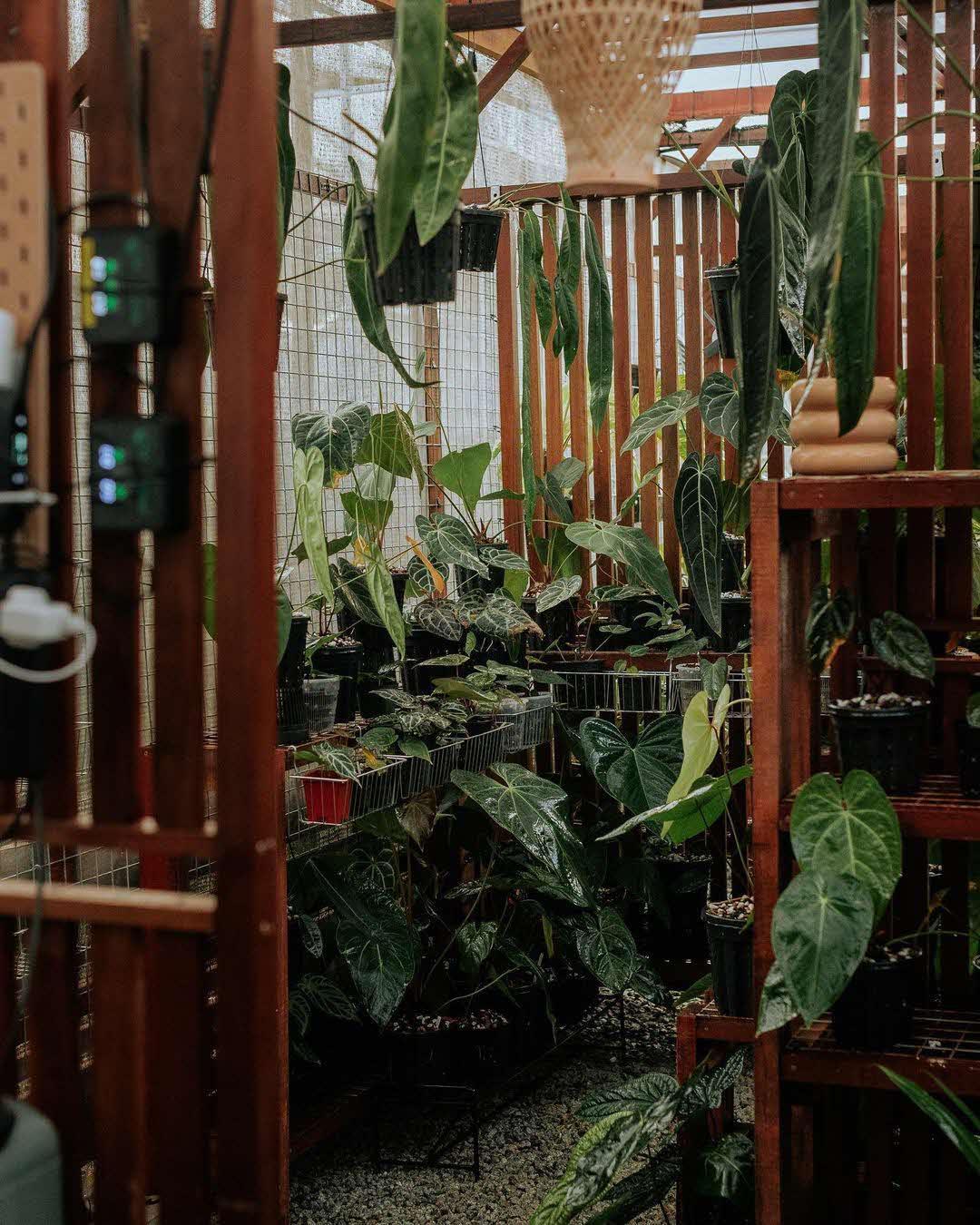Photographer & Plant Lover Afiq Omar Owns About 300 Plants
Covid-19 brought about much disruption to the lives of Singaporeans when it hit in 2020. People suddenly found their busy work schedules empty and had to pivot to other activities to keep themselves occupied.
One hobby that saw a spike in interest over the last few years was gardening. Many found the time and patience to nurture plants, with some even ending up with an extensive collection large enough to rival a small nursery.
That was exactly what happened to 35-year-old photographer Afiq Omar.

Source: @rumabotanika on Instagram
At work, the managing director of photography and videography collective Colossal Productions is a stickler for visuals. Outside of work, he is a lover of all things nature.
And today, he is the proud owner of almost 300 plants, which he keeps at a small nursery plot in Seletar.
Obsession with plants started with wanting to beautify his studio
Speaking to MS News, Mr Afiq recalled buying his first houseplant sometime in 2021. At that point, he only wanted to find some simple greenery to liven up his photography studio.
After unwittingly “killing” many plants in the process, Mr Afiq’s interest in gardening was piqued as he started researching how to keep them alive for longer.
“When you kill one plant, you just buy another plant to replace it. But we kept killing and buying, to the point where we decided, ‘Okay, let’s not kill anymore of them’,” he recalled, chuckling.
As his collection slowly grew, he relocated most of them to the corridor of his parents’ HDB flat as he ran out of space in his studio. There, he built a futuristic-looking automated misting system, which went viral on TikTok.
@afiqomarali NEA lai liao and approved! They said amazing setup, zero pests! Welcome my friends, to my gardens by the corridor! #LazWinACondo #plantsoftiktok #fyp
The positive reaction to his blossoming interest was one of the main reasons he started to dive headfirst into the hobby.
Moved plants to nursery plot to give them best conditions to grow
Since then, Mr Afiq has moved his plants a total of three times. When he shifted out of his parents’ flat, his plants claimed temporary ownership of the balcony at the apartment he was renting.
Then, sometime in the second half of 2022, he moved them into a plot in a nursery at Seletar after coming across the space for lease. He thought his plants deserved a proper place to grow and not be inhibited by wherever he was staying.

Source: @rumabotanika on Instagram
“The conditions here are much better for the growth of the plants compared to the HDB corridor for sure,” he explained. “After a while, I started to feel a sense of responsibility for them, and I thought it was my job to make sure they grow well.”
Owns around 300 plants, many have leaves larger than his head
Take a gander at the lush, cosy space — which he’s christened “rumabotanika” — and you will find Mr Afiq’s now-extensive collection of plants and shrubbery, most of which are aroids.
Rumabotanika means “botanic house” in Malay.
He has filled the space front-to-back with leaves of varying shapes and sizes, but the photographer seems to have a special liking for those as big as — or even bigger than — his head.
His pride and joy, as well as rumabotanika’s centrepiece, is a pot of anthurium luxurians that sits at the centre of the nursery. It is easily the first plant that catches your attention when you walk into the small but beautiful garden.

Source: @leafing.around on Instagram
It’s his favourite because, unlike most anthurium luxurians with leaves that come in a regular heart shape, this one has a rare elongated shape and sinuses that overlap.
One might wonder how a busy media professional such as Mr Afiq tends to 250 to 300 plants at the same time.
Well, thankfully for him, his plants are mostly quite low maintenance.
“The guys here, they don’t need a lot of care, actually,” he said. “They are outdoor plants, so when it rains, that takes care of most of them. I usually come over once a week or every four days to make sure everything is okay.”
Plants & nature provide photographer with respite from hectic life
While the weekly watering sessions might look a little daunting to others due to the sheer amount of plants, Mr Afiq said that the task is still manageable for him.
One could say that he takes such good care of his plants because they take care of him.

Source: @rumabotanika on Instagram
“They provide me with the mental space and mental clarity I need,” he shared. “Whenever things get heavy, I come here to clear my head and recharge my social battery.”
Besides giving his mental health a boost, his love and passion for nature keeps him grounded and has fuelled many of his creative ideas as a visual artist.
Found plant lovers’ community online, shares tips with them
Mr Afiq is certainly not alone in his interests. Through social media platforms such as TikTok and Instagram, he’s been able to get in touch with like-minded plant enthusiasts and often exchange tips with them.

Source: @rumabotanika on Instagram
The sense of camaraderie extends offline too. Ever since Mr Afiq moved his plants into the nursery, he has made friends with neighbouring collectors and gardeners who share the same space.
“It is a very nice community here. We have open houses for the public to come to check out our collections, and we help each other out when needed, such as assisting with the cleaning of common corridors. It’s like a kampung, and I love it.”

Source: @afiqomar on Instagram
One of the main challenges many gardeners face, he noted, is getting rid of unwelcome pests and insects such as mosquitoes, millipedes, and spiders.
According to this plant hobbyist, the simplest way to do that is to have well-draining pots so that water can flow easily through the soil.
He also advised against placing a plant saucer underneath the pot as this collects stagnant water and might encourage mosquito breeding.
In situations where the use of plates is inevitable, such as for plants that are indoors or along the corridor, remember to empty them frequently. The same goes for vases.
By keeping bugs at bay, not only will you help your plants thrive, you’re keeping yourself safe too.
Singaporeans should take preventive & protective measures against dengue
Mr Afiq’s suggestion certainly comes at a good time as dengue fever is endemic in Singapore.
The National Environment Agency (NEA) advises everyone to carry out the Mozzie Wipeout at least once a week to protect themselves and their loved ones, which can be remembered with the handy acronym – B-L-O-C-K:
- Break up hardened soil
- Lift and empty flowerpot plates
- Overturn pails and wipe their rims
- Change water in vases
- Keep roof gutters clear and place BTI insecticide
These measures are crucial to ensuring that dengue-spreading Aedes mosquitoes do not have somewhere to breed, keeping you and those around you safe.
Additionally, you should also take the S-A-W protective measures against dengue, especially if you are living in dengue cluster areas:
- Spray insecticide in dark corners around the house
- Apply insect repellent regularly
- Wear long-sleeved tops and long pants
For more information on how to prevent dengue, visit the NEA website.
Protect yourself & your plants
In a busy, fast-paced society like ours, we must remember to take some time to slow down and smell the roses — or admire the greenery around us.
Even if you don’t have a garden or an entire nursery lot all to yourself, research has shown that even just having indoor plants can make a world of difference to one’s mental well-being. So perhaps it’s time to consider becoming a plant parent.
But when you do embark on the journey to green-thumbed status, don’t forget to take all the necessary steps to ensure that your home is free of pests and bugs so that everyone — yourself, your family, and your plants — are happy and safe.
This post was brought to you in collaboration with the National Environment Agency.
Featured image adapted from @rumabotanika on Instagram.

Drop us your email so you won't miss the latest news.









